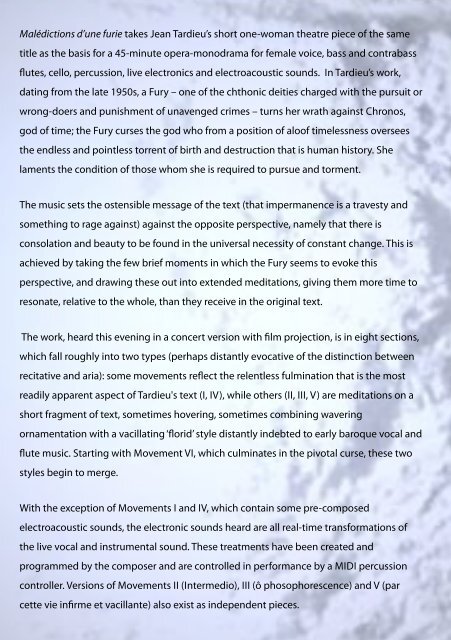JOHN CROFT MALÉDICTIONS D'UNE FURIE
JOHN CROFT MALÉDICTIONS D'UNE FURIE
JOHN CROFT MALÉDICTIONS D'UNE FURIE
- TAGS
- john
- croft
- furie
- johncroft.eu
You also want an ePaper? Increase the reach of your titles
YUMPU automatically turns print PDFs into web optimized ePapers that Google loves.
Malédictions d’une furie takes Jean Tardieu’s short one-woman theatre piece of the same<br />
title as the basis for a 45-minute opera-monodrama for female voice, bass and contrabass<br />
�utes, cello, percussion, live electronics and electroacoustic sounds. In Tardieu’s work,<br />
dating from the late 1950s, a Fury – one of the chthonic deities charged with the pursuit or<br />
wrong-doers and punishment of unavenged crimes – turns her wrath against Chronos,<br />
god of time; the Fury curses the god who from a position of aloof timelessness oversees<br />
the endless and pointless torrent of birth and destruction that is human history. She<br />
laments the condition of those whom she is required to pursue and torment.<br />
The music sets the ostensible message of the text (that impermanence is a travesty and<br />
something to rage against) against the opposite perspective, namely that there is<br />
consolation and beauty to be found in the universal necessity of constant change. This is<br />
achieved by taking the few brief moments in which the Fury seems to evoke this<br />
perspective, and drawing these out into extended meditations, giving them more time to<br />
resonate, relative to the whole, than they receive in the original text.<br />
The work, heard this evening in a concert version with �lm projection, is in eight sections,<br />
which fall roughly into two types (perhaps distantly evocative of the distinction between<br />
recitative and aria): some movements re�ect the relentless fulmination that is the most<br />
readily apparent aspect of Tardieu's text (I, IV), while others (II, III, V) are meditations on a<br />
short fragment of text, sometimes hovering, sometimes combining wavering<br />
ornamentation with a vacillating ‘�orid’ style distantly indebted to early baroque vocal and<br />
�ute music. Starting with Movement VI, which culminates in the pivotal curse, these two<br />
styles begin to merge.<br />
With the exception of Movements I and IV, which contain some pre-composed<br />
electroacoustic sounds, the electronic sounds heard are all real-time transformations of<br />
the live vocal and instrumental sound. These treatments have been created and<br />
programmed by the composer and are controlled in performance by a MIDI percussion<br />
controller. Versions of Movements II (Intermedio), III (ô phosophorescence) and V (par<br />
cette vie in�rme et vacillante) also exist as independent pieces.


